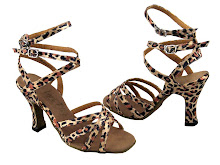Choosing the Right Dance Shoe for You
If you are at the stage of choosing an appropriate dance shoe, it means you have finally discovered the joy of ballroom dancing.
However, like any sport or physical pastime, the gear chosen can seriously affect one’s performance, enjoyment and appearance. Well chosen shoes will ensure better enjoyment of your dancing and permit you to do so for longer periods of time.
Construction:
Dance shoes are generally more lightweight and flexible with suede soles to ensure the right combination of “grip and slide” with the floor. They also typically have more padding in the insole to absorb the impact of dancing and generally have more toe room for added comfort.
Although many street shoes may be comfortable or stylish, they can easily lead to injury. Rubber soles often cause knee injuries from too much grip while leather soles are often far too slippery.
When choosing the right ballroom shoe, several factors must be taken into consideration.
Comfort and support should be first and foremost in choosing a style. Dancing directs an incredible amount of pressure into the feet and as such, choosing a comfortable shoe is paramount in making dancing a positive experience.
When first trying on a dance shoe, keep in mind that any noticeable pressure, friction or general discomfort will only become magnified after even just a few minutes of dancing. Select a shoe that fits snugly without excessive pressure.
Styles
One can typically choose from two basic styles: Latin or Standard (aka Rhythm or Smooth).
Latin: Latin shoes for ladies usually have higher, slimmer heels and typically sport an opening to show off the toes. Flared heels are often favored by dancers as they provide added stability. Also, many manufacturers offer a variety of strappy styles. One should generally aim to choose straps that are backed with non – stretchy material and 8mm or wider to provide the most support without cutting into the skin.
Additionally, depending on the supplier, Latin shoes may also be available with open backs. Open toes and heels, of course, provide more air flow to the foot, keeping one’s feet cooler. On the other hand, dancers who are seeking the highest degree of support and protection should aim to select shoes with a closed back and/or closed toe style of shoe.
Men’s Latin shoes typically carry a higher heel of up to 1.5 inches to help enhance movement of the hips in the Latin rhythms.
Standard: Standard shoes for ladies typically consist of a closed toe and a lower heel allowing for ease of movement across the floor versus Latin hip motion.
As mentioned above, they also provide added support and protection to the foot and toes.
Men will choose from a variety of shoes which typically sport a 1 inch heel.
Which one is right for you?
When new to the world of dance, ladies may want to choose an all purpose shoe that will work for a variety of dances such as a 2 – 2.5 inch shoe with good support. Black is often chosen for it’s suitability to match a variety of ensembles.
However, as one becomes more proficient, choosing different shoes for different occasions and styles is often ideal. Additionally, flesh-colored shoes are often chosen for their ability to lengthen leg lines.
Maintenance and Repair:
Expect to spend approximately $100 for a quality pair of shoes and keep in mind that dance shoes are in fact, not designed for extended wear. As such, they should be replaced regularly to ensure the best performance.
To extend the life of your dance shoes, never wear them outdoors or permit the soles to become wet. Consider brushing the suede soles with a specially made wire brush to maximize the correct amount of traction with the floor.
Wednesday, February 24, 2010
Subscribe to:
Posts (Atom)
